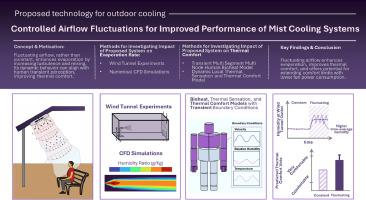控制气流波动,提高喷雾冷却系统的性能:增强蒸发和热舒适性
IF 7.1
1区 工程技术
Q1 CONSTRUCTION & BUILDING TECHNOLOGY
引用次数: 0
摘要
全球气温不断升高,给人们带来热压力,因此需要可持续的室外降温解决方案。喷雾降温大有可为,这项研究提出了一种新方法:将波动气流纳入喷雾系统。我们假设,雾冷波动气流可以为人们提供更高效的室外降温,原因有两个:风洞实验和数值模拟支持了这一假设,结果表明,与平均速度相同的恒定气流相比,波动气流可提高蒸发率。频率越低、振幅越大、梯度越陡的剖面,蒸发率越高。这些发现假设了一个理想化的领域,不包括自然风模式。此外,预测结果证实,与恒定气流相比,波动气流始终能提供更好的热舒适度。与不带喷雾的波动气流相比,带喷雾的波动气流在实现同等舒适度的同时,能耗降低了 38%,与带喷雾的恒定气流相比,能耗降低了 81%。拟议的技术具有改善室外舒适度和降低资源消耗的潜力。该技术具有可扩展性,并不复杂,可在现有系统中实施,但可能面临风扇部件磨损加剧等挑战。本文章由计算机程序翻译,如有差异,请以英文原文为准。

Controlled airflow fluctuations for improved performance of mist cooling systems: Enhanced evaporation and thermal comfort
Rising global temperatures and resulting heat stress on people necessitate sustainable outdoor cooling solutions. Mist cooling offers promise, and this work proposes a novel approach: incorporating fluctuating airflows into misting systems. We hypothesize that mist-cooled fluctuating airflows could provide more efficient outdoor cooling for people, for two reasons: 1) Increased turbulence and mixing promoting higher water evaporation rates; 2) dynamic airflow leveraging transient thermal perception for improved comfort.
Wind tunnel experiments and numerical simulations support this hypothesis, revealing that fluctuating flow, compared to constant flow with the same average velocity, enhances evaporation. Lower frequencies, higher amplitudes, and profiles with steeper gradients led to higher evaporation rates. These findings assume an idealized domain, excluding natural wind patterns. Furthermore, predictions confirmed that fluctuating flows consistently provide superior thermal comfort compared to constant flows. Fluctuating airflow with misting achieved equivalent comfort at 38% lower energy consumption compared to fluctuating flow without misting and 81% lower compared to constant flow with misting. The proposed technology has the potential to improve outdoor comfort and decrease resource consumption. It is scalable, not complex, and can be implemented into existing systems, though it may face challenges such as increased wear on fan components.
求助全文
通过发布文献求助,成功后即可免费获取论文全文。
去求助
来源期刊

Building and Environment
工程技术-工程:环境
CiteScore
12.50
自引率
23.00%
发文量
1130
审稿时长
27 days
期刊介绍:
Building and Environment, an international journal, is dedicated to publishing original research papers, comprehensive review articles, editorials, and short communications in the fields of building science, urban physics, and human interaction with the indoor and outdoor built environment. The journal emphasizes innovative technologies and knowledge verified through measurement and analysis. It covers environmental performance across various spatial scales, from cities and communities to buildings and systems, fostering collaborative, multi-disciplinary research with broader significance.
 求助内容:
求助内容: 应助结果提醒方式:
应助结果提醒方式:


